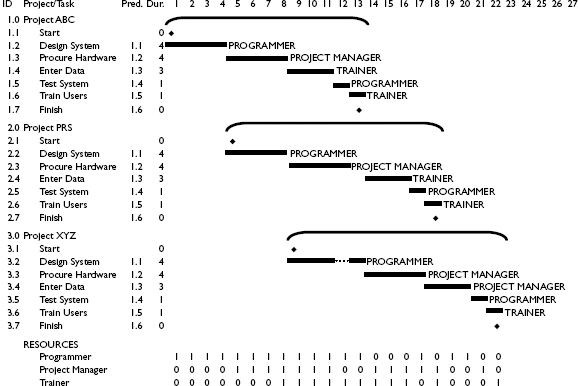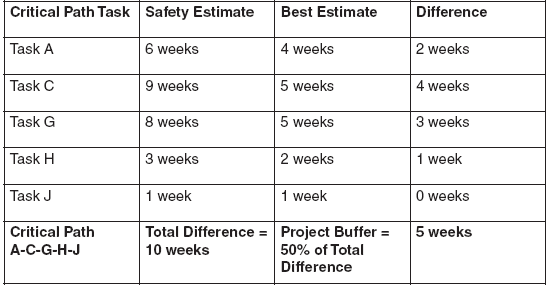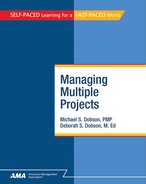Advanced Scheduling Techniques for Multiple Projects

Learning Objectives
By the end of this chapter, you will be able to:
• Determine which of the seven most common priority-setting algorithms for multiple projects best fits your multiple project environment.
• Apply the five-step process of Least-Resource Scheduling to optimize multiple project management.
• Apply the precepts of Critical Chain Project Management to your multiple project environment.
Estimated timing for this chapter:
| Reading | 30 minutes |
| Exercises | 1 hour 20 minutes |
| Review Questions | 10 minutes |
| Total Time | 2 hours |
JIGSAW PUZZLES, LEAST RESOURCES, AND THE CRITICAL CHAIN
In Chapter 6, you learned the mechanics of scheduling resources on single and multiple projects. How do you ensure that your answer is optimal? Are there shortcuts or techniques to speed up the work?
If you like jigsaw puzzles, you are well suited to the work of optimizing a schedule, but project managers are a varied lot. Some of us just want to get on with the work itself. In solving a jigsaw puzzle, people often use strategies to sort pieces into useful groupings: checking small details from the box cover photo to move pieces into likely areas, looking for edge pieces, and color-coding. These are examples of algorithms, rules specifying how to solve some problem.
Algorithms vary in quality and usefulness; some are mere “rules of thumb,” with as many exceptions as cases that fit. When it comes to managing multiple projects, the available algorithms are somewhat better than rules of thumb. The complexity of project issues is so great, however, that no tool can achieve a perfect schedule. In using the tools in this chapter, you must be aware of their limitations as well as of their advantages.
PRIORITY-SETTING STRATEGIES FOR MANAGING MULTIPLE PROJECTS
A 2007 study of methods for priority setting in multiple project management in healthcare identified seven priority-setting algorithms (Hopkins, et al.), shown in Exhibit 7-1. For each, the study listed conditions under which the algorithms performed best.

Exercise 7-1
Determining Priority of Multiple Projects
Which of the seven priority-setting strategies is right for you? Write “Yes” or “No” for each situation. Based on the number of “Yes” answers, determine the strategy or strategies likely to be most successful for you.
| Issue | Does It Apply to Me? (Yes/No) | Strategies to Consider |
| Work packages are simple. | FCFS, LST | |
| New projects arrive randomly. | FCFS | |
| Most projects are short. | SASP | |
| Resources are in good supply. | SASP | |
| Resource demands are high. | MAXTWK | |
| Deadlines are serious and stable. | RSM, LFT | |
| A number of projects have started simultaneously. | MTS | |
| The network diagram is very complex. | LFT | |
| Resources are constrained. | MAXTWK, LST | |
| Estimates are not reliable. | LST |
Most appropriate method for my multiple projects: _____________________________________
xhibit 7-1
Priority-Setting Algorithms for Multiple Projects
| Algorithm | Definition | Suitable Under These Circumstances |
| First Come, First Served (FCFS) | Assign resources to the first eligible work package that shows up, regardless of other factors. | When work packages are simple and new projects arrive randomly. |
| Shortest Activity for the Shortest Project (SASP) | Prefer short projects with short activities to accomplish the greatest number of projects | When most projects are short and resources are in good supply. |
| Maximum Total Work Content (MAXTWK) | Assign resources to the jobs that require the most resources, regardless of deadlines. | When demand for resources is high, because those resource-intensive jobs become bottlenecks keeping major work from getting done. |
| Resource Scheduling Method (RSM) | Schedule according to the degree of time sensitivity. | When deadlines are serious and don’t tend to move around a lot. |
| Most Total Successors (MTS) | Give priority to the activities with the largest number of successor activities that require completion before another activity can begin. | When a number of projects have started simultaneously and have shared resources. |
| Minimum Late Finish Time (LFT) | Take into account the late finish, rather than the early finish of tasks; schedule so activities with the earliest late finishes get priority. | When the network diagram is complex and the deadline is strict. |
| Minimum Late Start Time (LST) | Similar to LFT, this technique schedules according to the earliest late start. | When you have simple or single projects with constrained resources, or when there is doubt about the quality of the estimates (such as widely varying skill levels among team members, likelihood of rework, and lack of foreknowledge about the work needing to be done). |
xhibit 7-2
Five Steps to Least-Resource Scheduling
1. Lay out time-fixed projects first.
2. Determine and schedule resource requirements.
3. Identify available resources for remaining projects.
4. Use least-resource scheduling to optimize production.
5. Fit the final schedule together.
LEAST-RESOURCE SCHEDULING
Least-Resource Scheduling first appeared in 1999 (Dobson, Juggler’s Guide). It lays out a five-step process for optimizing resources in a multiple project environment, shown in Exhibit 7-2.
Lay Out Time-Fixed Projects First; Determine and Schedule Resource Requirements
In the last chapter, you completed Exercise 6-4 to gain hands-on familiarity in managing multiple projects. Let’s assume you’re the manager of a program of independent projects, and you’ll be doing a non-stop stream of similar projects. Exhibit 7-3 shows the textbook answer to that problem, along with a resource requirements list for the three members of your team.
In the example, all the projects are identical, which would likely not be the case in real life. Even so, notice that subtle differences creep in as the number of projects and the number of interactions increase. The Trainer enters data in projects ABC and PRS, but the Project Manager has to do it for project XYZ while the Trainer trains the PRS users. On Project XYZ, the Programmer has to interrupt “Design System” for a week while she tests the system for ABC. Add a few more projects, and you’ll see the basic template continue to change as three people juggle an increasing number of simultaneous projects.
One trouble with the various scheduling algorithms explored previously is that they are one-size-fits-all answers. Even identical projects can be done for very different reasons. The customer for ABC needs a price break. The customer for PRS has a very strict deadline. And the customer for XYZ demands exceptional performance.
Incompatible requirements can be a scheduling opportunity. In the first step of your process, identify those projects that have strict or challenging deadlines, or that have a high degree of urgency. Starting with the deadline for each, schedule those projects backward into your schedule. Now you know the latest date when each of those projects can start. For the time being, ignore any project with a driver of either cost or performance. Time gets the right-of-way in the schedule. Cost- and performance-driven tasks are added second.
xhibit 7-3
Multiple Project Program

Identify Available Resources for Remaining Projects
Exhibit 7-3 shows that all the necessary resources have been assigned to accomplish the work scheduled so far: but remember, that’s only the work that has strict deadlines.
There are significant quantities of unscheduled resources, represented by all the “0” entries for each of the three team members. (As Martha Stewart famously says, “That’s a good thing.”) The question becomes, how best to use those resources to accomplish additional work.
Schedule the Least Resource; Fit the Final Schedule Together
For the remaining work, schedule resources in the reverse order of their flexibility: schedule the least-available resource in the most efficient manner possible, fitting other resources around the least resource in the order of increasing flexibility. How do you determine the least resource? You may need to consider more than one approach.
First, you could determine the least resource by overall supply. The programmer has six unscheduled weeks; the project manager has nine; and the trainer has eleven. This implies that the programmer is the least resource. This is not always sufficient evidence, however, because the contribution specialists make to the project is not necessarily equal. One project takes five weeks of programming, four weeks of project management, and one week of training. This still argues for the programmer being the least resource, especially since the project manager and trainer are interchangeable on at least one task.
Because the programmer is the least-available resource, you can give priority to assignments that use the programmer most efficiently. Add in other resources in the inverse order of their availability, and you’ll be well on the way to an efficient schedule.

Exercise 7-2
Least Resource Scheduling
In this exercise, your job is to optimize the schedule for the following set of multiple projects. You have one designer, one project manager, and a team of workers that you will treat as a single resource.

Which resource is the least resource? ______________________________________________
Prepare a schedule for all the project work, optimizing the least resource first.
CRITICAL CHAIN PROJECT MANAGEMENT
Critical Chain Project Management comes from the Theory of Constraints, a management philosophy developed by Dr. Eliyahu Goldratt, to respond to what he saw as a systematic failure of standard project management processes. Because it takes into account both resource-dependent and precedence-dependent links among work packages, it has special application to managing multiple projects.
A full exploration of Critical Chain Project Management would require a separate course; the bibliography provides two books on this subject, and you can get more information at http://www.goldratt.com/.
Searching for Resource Dependencies
In traditional project management, you focus on logical dependencies — the reasons one task has to follow another, as in you can’t pour the concrete until you finish digging the hole.
As you saw in the multiple project schedule in Exhibit 7-3, some tasks are linked not because of logic, but because of resource availability. The programmer can’t start Task 2.2 until Task 1.2 is complete, even though Task 1.2 is in a completely different project. All too often, you can have a situation in which a problem in one project is solved, but it requires shifting resources in such a way that other projects run late. These dependencies are too often unseen because they’re implicit, not explicit. And most importantly for multiple project managers, they often cross individual project boundaries. The charts for Project ABC don’t reveal the consequences for Project XYZ if Task 1.3 goes late, so their decision-makers don’t take downstream impact into consideration.
That, of course, is where the manager of multiple projects comes in. Your problem is magnified because the estimates for task duration are often highly uncertain. Will the programming really take exactly four weeks, or is the actual range somewhere between 3.5 and six?
When basic uncertainty is high, you can’t achieve a perfect solution, so the Critical Chain approach doesn’t try. A “good enough” solution is, well — good enough. Besides, there’s no known way of finding the perfect solution to a schedule.
Project Buffer, Feeder Buffers, Resource Buffers
One “good enough” solution is called buffer management. A buffer is a kind of project reserve, time (and sometimes resources) we set aside to absorb the expected uncertainty in our tasks. There are two types of time buffers: the project buffer (reserve for the overall project schedule) and feeder buffers (reserve for noncritical paths).
Project Buffer
The project buffer is extra time before the final deadline. A team that set up numerous trade show events each year had a policy that the official deadline for each show was two weeks before the actual show date: everything had to be done and ready. Of course, they never achieved the revised deadline, but they achieved their real goal: they were always done before the trade show started.
People have used informal buffers for years. The trade show team didn’t conduct any analysis to determine that two weeks was a good buffer; it was simply a guess. Our recommendation for most multiple project managers is to start with a reasonable guess and adjust with experience. Depending on the complexity and challenge of your situation, and the level of your comfort with statistical analysis, you may want to apply a more mathematically rigorous approach, which the Critical Chain approach provides.
When gathering estimates for how long it will take to complete work packages, ask for two estimates: a safety estimate (90% sure of success) and a best estimate (nothing goes wrong; 50% sure of success).
Psychologically, when people strive for the shorter deadlines, they don’t always make them, but they usually end up ahead of their safety estimates. When people start with their safety estimates, it’s more common that the work package takes longer than their supposedly safe estimate! So put the best estimates in the schedule! Instead of padding each activity, guaranteeing a loss of urgency, put a buffer at the end of the project to absorb the inevitable slippage.
Here’s one quick way to calculate a buffer without a lot of math. For the tasks on the critical path, add up the 90% estimates, and do the same for the 50% estimates. The project buffer should be half the difference between the two sums. Exhibit 7-4 provides an example.
Feeder Buffers
The project buffer applies to the critical path, but that’s not the only source of schedule risk. You want to make sure that noncritical activities don’t overrun their available float. Instead of leaving the float in the individual tasks, you add a feeder buffer, sized in the same way as the project buffer, but for only those tasks in the particular path segment. That way, people concentrate on the best estimate, not the safety one. You and the project will normally be more successful.

xhibit 7-4
Sizing the Project Buffer

Putting Buffers in the Project Plan
In building a network diagram or a Gantt chart, treat a project buffer as any other task in the schedule. A buffer, of course, does not consume resources, so doesn’t count toward the resource loading. And unlike a normal task, it shrinks if its predecessor tasks go late, instead of moving its anticipated finish date to the right.
Resource and Cost Buffers
The advantage of schedule buffers is that a certain amount of schedule flexibility, in the forms of float and uncertain estimates, simply appears in the plan. You don’t have to ask management or the customer for it.
When planning the schedule, look for potential flexibility in resources, from people to equipment to money. The best candidates are resources that would otherwise go idle. There’s little or no net cost in using them.
Managing the Buffer
Because you’ve deliberately entered the best estimate for each work package into your schedule, you know there’s only a 50% chance that a task will meet the deadline. Therefore, it’s not fair to criticize or punish a team member who fails to meet what is, after all, an aggressive target. Instead, remove the worry by establishing three rules for team members.
You have done your work successfully if you:
1. Start on the work as soon as you are able.
2. Hand the output over to the next person, team, or task as soon as you are able.
3. Don’t do anything else as long as you can continue to do useful work on your current task.
By improving focus, cutting down destructive multitasking, and starting with a challenging project, the project is off to a much better start.
Of course, tasks will run late, and that’s what the buffer is for. Because you expect 50% of tasks to be late, your buffer is sized at 50% of the expected difference between the best estimate and the safety estimate. Don’t worry if your buffers begin to shrink; that’s what they’re for. As long as total slippage in a buffer is under 1/3 of the total time, there’s no problem. If the buffer slips into its second third, it’s time to start looking at potential solutions, even though you’re not in trouble yet. If the buffer slips into its final third, it’s time to act.
Buffer management takes into account the reality of project uncertainty, helps keep all your projects on deadline, and focuses the attention of team members on getting results. While Critical Chain methodology is not universally accepted, the project management consulting firm the Standish Group reports that—while only 44% of standard projects finish on time, within budget, and with scope accomplished—the success rate for Critical Chain projects approaches 95%.
Exercise 7-3
Mapping the Critical Chain
Using the Gantt chart from Exercise 7-2, mark the Critical Chain — the chain of resource dependencies — by connecting the longest sequence of tasks that use the same resource.


To ensure that you are scheduling your resources in the best way, use one of the seven basic priority-setting algorithms to decide which task comes next in your workflow: First Come, First Served (FCFS); Shortest Activity for the Shortest Project (SASP); Maximum Total Work Content (MAXTWK); Resource Scheduling Method (RSM): Schedule according to the degree of time sensitivity; Most Total Successors (MTS); Minimum Late Finish Time (LFT); or Minimum Late Start Time (LST).
Least-Resource Scheduling adopts a five-step process for optimizing a schedule of multiple projects: lay out time-fixed projects first; determine and schedule resource requirements; identify available resources for remaining projects; use least-resource scheduling to optimize production; and fit the final schedule together. The “least resource” is the resource in least supply. By scheduling the least resource first, you minimize the negative effects of bottlenecks in your process.
The Critical Chain Project Management methodology provides an alternative to traditional project management thinking, based on the Theory of Constraints management philosophy. Of interest to managers of multiple projects is the concept of resource dependency, the implicit linkage that two tasks have when they share the same resource. Because resource dependencies across project boundaries often escape notice, lateness on one project can have a ripple effect on many other projects.
Critical Chain prefers to use best estimates rather than safety estimates in developing a schedule. It manages project uncertainty through the use of buffers, extra time before the next deadline or schedule merge point. By monitoring the buffers, the multiple project manager can act before schedule slippage gets out of control.
Review Questions
|
1. Shortest Activity for the Shortest Project (SASP) is a priority-setting method recommended when: (a) the network diagram is complex and the deadline is strict. (b) most projects are short and resources are in good supply. (c) a number of projects have started simultaneously. (d) work packages are simple. |
1. (b) |
|
2. Establishing extra time before the final deadline and putting it at the end of the critical path is known as a: (a) feeder buffer. (b) Resource Scheduling Method (RSM). (c) safety estimate. (d) project buffer. |
2. (d) |
|
3. The least resource is the: (a) poorest performer on your project team. (b) inexpensive choice when getting things done. (c) resource in the shortest supply to meet project demands. (d) most expensive team member to use. |
3. (c) |
|
4. Incompatible requirements for different customers on different projects provides: (a) a scheduling opportunity. (b) increased chance of error. (c) an excuse for poor quality. (d) higher costs and prices. |
4. (a) |
|
5. A priority-setting technique that is useful when a number of projects have started simultaneously and use shared resources is called: (a) First Come, First Served (FCFS) (b) Most Total Successors (MTS) (c) Minimum Late Start Time (LST) (d) Maximum Total Work Content (MAXTWK) |
5. (b) |

